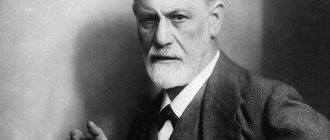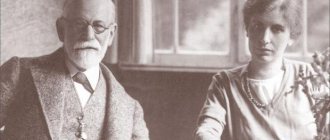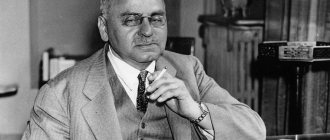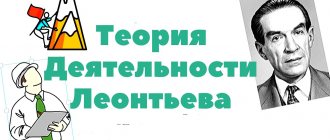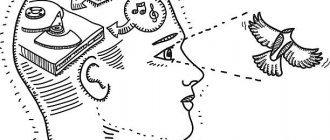- October 11, 2018
- Psychological terms
- Valeria Marutkova
Often doctors and psychologists working in the field of psychoanalysis use the term “mortido”, which in their work symbolizes the destructive principle in a person’s personality. In order to indicate the level of this feeling, they also use the term “destrudo”.
According to Freud, the individual is driven by two main instincts: libido and mortido. The first is a craving for life, the second is a destructive beginning.
Let's understand the meaning of these two terms and reveal what libido and mortido are in clear words.
Libido is...
Most people, when they hear the word “libido,” understand it as sexual attraction to a person, but this word has a much broader meaning. In psychology, libido is not only sexual desire, but also the instinct for maintaining life and creative energy.
The term was first introduced in 1868 by M. Benedict. Then it meant only sexual attraction. In his treatise, The Theory of Libido, Freud presented the drive as the center of the idea of psychoanalysis. Freud argued that because of libido, a person develops and grows, and it is this that is the reason for actions and desires. The author divided libido into three components: drive, impulse and object. By linking together sexual desires and sexual relations, we can talk about the unity of objects of desire.
In the second dualistic theory of drives, psychoanalyst Freud contrasted libido and mortido in psychology. This gave rise to research into the death instinct and destrudo. He began to consider the vital energy underlying sexual desires. The author did not associate the term only with sex, but tried to understand it in a broader sense, analyzing both love and passion. Freud believed that if the accumulated libidinal energy does not find its way out, it can lead to mental disorders.
At the same time, Carl Jung moved as far as possible from understanding the word “libido” as sexual desires and drew parallels with qi and prana, trying to find an explanation in the lifestyle of less developed peoples.
Cathexis
Also, to better understand what mortido is, it is necessary to consider the concept of cathexis. This word refers to the direction of attraction. For example, if a person fell in love, it means that he cathected his attraction into the object of his choice. In other words, cathexis is the placement of the energy of attraction.
Psychologists believe that a person has a need to cathect not only libido, but also mortido. This suggests the following: people not only crave to love and be loved; perhaps we have a built-in need to hate and to be hated.
Second dualistic theory of drives
So, Freud contrasted libido and mortido as the desire for life and the desire for death.
Psychiatrist student Sabina Spielrein, based on this theory, wrote her work “Destruction as the Cause of Formation,” which gave rise to a more in-depth study of the death drive. Spielrein draws a parallel in his work between mortido and deeply hidden masochism. Sabina believed that the desire to destroy one’s own personality stems from a deep-seated desire for death. In her doctoral dissertation, she drew attention to the fact that the conscious disintegration of personality and the desire for self-destruction often becomes a source of creative and social growth.
Many scientists and psychologists (Spielrein, Jung, Adler, Scheckel) were engaged in research in search of an answer to the question of the human death drive, but only Sigmund Freud was able to collect all their thoughts and ideas into a specific concept and covered the topic in detail in the second dualistic theory of drive. In this work, he was able to reveal the connection between libido and mortido in psychology and for the first time contrasted them with each other.
Based on the work of Freud and Spielrein, the term “destrudo” gained popularity, which Paul Federn later studied.
Destructive force
At least, this is the opinion of psychoanalysts. After all, if a person does not project his mortido onto other people, then it begins to destroy him. Such cases occur frequently in psychotherapy. A person divorces a spouse who has terrorized him for a long time, or moves away from oppressive parents. It would seem that now a pleasant and free life should begin. However, such clients began to get sick and degrade as individuals. Since the object that hated them disappeared, the mortido energy began to destroy them.
This is why in psychotherapy clients are taught to cope with their emotions and redirect them towards creativity. Art therapy occupies an important place in psychology. Mortido is an energy that is most easily expressed in the form of images, music, dance. Then there will be no need to take out evil on others. By turning to creativity, a person stops destroying himself.
Characteristics of mortido
Mortido is the opposite of libido, expressed in a person’s conscious desire to destroy his own personality at any level: psychological, physical, social. This desire can also be called a counterbalance to the instinct of survival, which is characteristic of any living organism.
Mortido is an internal force, an energy that causes a person to have a desire for destruction, murder, and violence. This is a desire for death, anger, manifestation of aggression in various forms.
What it is
Mortido energy is one of the two fundamental driving and motivating factors in all human expressions.
It is aimed at death and helps to distinguish everything that is unfamiliar, dangerous, possibly causing pain, i.e. on a subjective level, a person experiences these feelings as fear and potential danger, after which he nevertheless makes a choice towards contact with such energy. The mortido program is activated by unconscious mechanisms and has a great influence, despite the validity of the instinct for survival. Perhaps this is why in the broad theoretical field such a concept has not been consolidated widely and firmly, but is used only in borderline studies, where the researcher himself has the courage to come into contact with death and destructive tendencies, as well as the opportunity to recognize their necessity and important role in the formation of life. ways.
It is impossible to ignore the energy of death in a person’s mental space, since even at the biological level it has confirmation not only of its existence, but also of its direct influence on life. All types of animal aggression are interpreted as projective actions, in fact, an ongoing program of self-destruction. This is the basic level of manifestation of destructive energy - physical, characteristic of all living organisms.
As human consciousness develops, mortido begins to manifest itself at the biological level, when a person drives himself into depression, falls under the influence of various addictions, and also chooses a lifestyle that only leads to the degradation of basic psychoneurological functions. With a high proportion of projection, mortidosis energy is not appropriated and has little effect on the person himself, but begins to be actively produced into the external environment, triggering the highest level of its manifestation - social.
Here, both murder and verbal aggression, unlawful behavior, outbursts of discontent that are excessive in their emotional intensity, as well as the deliberate destruction of the social system as a safe system for the life of the entire species are possible.
Unrealized energy
We can say that libido and mortido are levers that control any person. There is a theory according to which libido, which has not found an outlet, turns into destrudo. In other words, if an individual cannot fully realize his sexual needs, then the accumulated energy turns into the energy of destruction. This manifests itself in increased aggression towards oneself and towards others, in unfounded outbursts of rage, which are sharply replaced by passivity and depressed mood, causing apathy.
Physiologically, mortido manifests itself in slow metabolism, decreased immune activity, and decreased production of hormones. There is an imbalance of endorphins and enkephalins, which leads to prolonged depression. Due to the inability to fulfill its basic needs, the body produces enkephalins instead of endorphins, the hormones of happiness, which cause melancholy, anxiety, and a depressed state.
Periods of development of S. Freud's doctrine of the unconscious
According to Freud, the human psyche is divided into three areas:
- Consciousness;
- Unconscious;
- Preconscious.
All three areas are in a state of continuous interaction, and the first two are also in a state of intense struggle among themselves. The mental life of a person, the scientist believes, comes down to precisely this interaction and struggle. Every human act and mental act must be considered as the result of a competition and struggle between consciousness and the unconscious.
The concept of the unconscious did not develop immediately and went through several periods:
The first period of Freud's concept. At this stage, the concept of the unconscious is very close to the teachings of such French psychiatrists and psychologists as Charcot, Liebeau, Janet, and one can say that it is directly genetically dependent on them; Second period. It is the longest and most important in the development of psychoanalysis. At this time, all the main and characteristic features of Freud’s teaching on the unconscious are determined, which becomes completely original
The unconscious becomes a necessary and important part of the mental apparatus of every person. The struggle between consciousness and the unconscious is declared to be a constant and natural form of mental life.
For all areas of cultural creativity, the unconscious becomes energy and a productive source of psychic forces. But the unconscious can also become the source of all nervous diseases. Thus, in the second classical period of psychoanalysis, the concept of the unconscious is enriched with a number of new, significant aspects. Third period. The concept changes significantly and comes closer to the metaphysical teachings of Schopenhauer and Hartmann. The unconscious becomes the embodiment of everything lower and everything higher in a person. A new division appears instead of the previous one:
- Sexual attraction or eros;
- Attraction to death.
The basis of all manifestations of aggressiveness, cruelty, murder and suicide are the death instincts.
The instinct of self-preservation has been transferred to sexual desires; it includes sub-instincts that make any organism alive:
- Nutrition;
- Height;
- Breath;
- Movement.
With the development of civilization, the instinct of self-preservation lost its significance and the instinct of reproduction or libido took first place.
Trying to penetrate the mechanisms of the human psyche, Freud proceeds from the fact that its natural, deep layer (“It”) functions according to an arbitrarily chosen program for obtaining the greatest pleasure. But the individual, in satisfying his passions, encounters a reality that contradicts “It”. This contradiction is associated with the isolation of the “I,” which seeks to curb unconscious drives and channel them into socially approved behavior.
The task of psychoanalysis formulated by Freud is to transfer the unconscious material of the human psyche into the realm of consciousness and subordinate it to its goals. In this regard, Freud was an optimist and believed in the ability to become aware of the unconscious.
The analytical activity of the scientist was aimed at ensuring that a person, as the nature of the unconscious is revealed, could master his passions and consciously manage them in real life.
Energy of instincts
So, the term “destrudo” was used to denote the magnitude of the death instinct. The founder of the theory of mortido and libido was Freud, but he himself did little about it, but his students continued to work on research. They were based on a concept that assumed the duality of human personality. That is, in every personality, libido and mortido are the two main instincts that must be balanced and focused on creation for normal life. Otherwise, everything will turn into destrudo - destruction, aggression, depression.
Manifestation mechanism
A destructive drive is activated when a person’s needs are not met. What needs are particularly closely related to mortido?
- The need for procreation.
- The need to acquire a certain status in a hierarchical system of relationships.
- The need for self-affirmation.
As a result, a person is in a depressed, melancholy state, he has a feeling of anxiety and fear, and thoughts of death appear.
We recommend: Who is a melancholic person?
Destrudo is...
What is destrudo? These are destructive actions of a person aimed at himself or the world around him. It is distinguished from the death instinct only by direction and implementation. In simple words, mortido is an instinct, and destrudo is a specific action or state. Destrudo can be used as a way to decipher the patient's attitude and state of mind.
It is impossible to determine exactly the mood of human behavior and its motives. In addition, not all scientists, psychologists, and doctors share the theory of human duality. According to Freud's theory, the highest way of manifestation of libido is sexual intercourse, and mortido is murder. It is worth recognizing that one way or another, both of these instincts influence modern man with one force or another.
Isolation from the outside world
Not in the literal sense, when you buy buckwheat in huge quantities so as not to go out for several months. It could be a simple reluctance to leave the house anywhere other than to work or to the store.
Even knowing that it would really be very useful for you to unwind, take a break from the endless routine and finally see your friends over a glass of beer, you prefer to stay at home, finding reasonable reasons for this behavior. “I’m having health problems right now—I don’t want to be a burden to anyone” or “I bore them with my presence because I can’t have as much fun” are sure signs that all is not well.
Unconscious
This is the deepest and most significant layer of the human psyche. It represents a kind of repository of memories, emotions and instinctive impulses. Such manifestations at one time threatened consciousness so much that they were suppressed by man and pushed into this area by him. Nevertheless, this material, unconscious to the individual, largely determines his daily functioning. Those experiences that have moved into the area of the unconscious are inaccessible to human consciousness. Nevertheless, they have a certain influence on people's actions.
In his popular philosophy of the Ego, the Id, and the Superego, Freud distinguishes three types of unconscious. In a descriptive sense, it is not the subject of psychoanalysis. In the dynamic concept, the unconscious means a conflict that displaces experiences from consciousness. This area is also considered in a structural sense. At the same time, Freud notes that the unconscious operates according to special laws that can control mental activity. Among them:
- inability to distinguish between reality and fantasy;
- lack of time and principle of contradiction, etc.
As a result of many years of clinical observations, the Freudian concept of personality was created. “I”, “It” and “Super-I” in it became the designations of the three components of personality. Let's consider their description according to the theory of psychoanalysis.
Physiology
Activation of mortido is an inhibition of metabolism, hormonal release and immune activity, leading to a permanent depressive mental status due to an endorphin-enkephalin imbalance in brain neurochemistry.
It is assumed that the activation of mortido occurs as a result of unsatisfaction of basic biological needs (needs for reproduction, programs for social, material self-affirmation, increasing hierarchical status), initially this program gives a signal: instead of the release of endorphins - internal drugs (morphinomimetic peptides that give a feeling of happiness, cheerfulness , euphoria, self-confidence) - there is a release of enkephalins, which act on the mental continuum in exactly the opposite way - leading to a depressive state, a feeling of melancholy, fear and unwillingness to live.
Recommendations
- Charles Rycroft, A Critical Dictionary of Psychoanalysis
(London, 1995) p. 104 - Jadran Mimica, Explorations in Psychoanalytic Ethnography
(2007) p. 78 - Salman Akhtar, Great Dictionary of Psychoanalysis
(2009) p. 176 - Eric Berne, A Layman's Guide to Psychiatry and Psychoanalysis
(Middlesex, 1976), p. 101 - Franz Alexander et al., Pioneers of Psychoanalysis
(1995) p. 153 - Akhtar, s. 176
- Bern, Layman's Guide
, paragraph 16 - Bern, Layman's Guide
, paragraph 69 - Berne, Layman's Guide
par. 95 and p. 214 - Bern, Layman's Guide
paragraph 124 - Parsley Clarkson, Transactional Analytic Psychotherapy
(1993) p. 5 - Bernard Golsé "Destrudo"
- Jean Laplanche / John Fletcher, Essays on Otherness
(1999) p. 34 - Keith Tudor, in B. J. Brother, Power and Partnership
(1995) p. 71 - Z. B. S. Halevi, Introduction to Kabbalah
(1991) p. 197
What it is
Mortido energy is one of the two fundamental driving and motivating factors in all human expressions. It is aimed at death and helps to distinguish everything that is unfamiliar, dangerous, possibly causing pain, i.e. on a subjective level, a person experiences these feelings as fear and potential danger, after which he nevertheless makes a choice towards contact with such energy.
The mortido program is activated by unconscious mechanisms and has a great influence, despite the validity of the instinct for survival. Perhaps this is why in the broad theoretical field such a concept has not been consolidated widely and firmly, but is used only in borderline studies, where the researcher himself has the courage to come into contact with death and destructive tendencies, as well as the opportunity to recognize their necessity and important role in the formation of life. ways.
It is impossible to ignore the energy of death in a person’s mental space, since even at the biological level it has confirmation not only of its existence, but also of its direct influence on life. All types of animal aggression are interpreted as projective actions, in fact, an ongoing program of self-destruction. This is the basic level of manifestation of destructive energy - physical, characteristic of all living organisms.
As human consciousness develops, mortido begins to manifest itself at the biological level, when a person drives himself into depression, falls under the influence of various addictions, and also chooses a lifestyle that only leads to the degradation of basic psychoneurological functions. With a high proportion of projection, mortidosis energy is not appropriated and has little effect on the person himself, but begins to be actively produced into the external environment, triggering the highest level of its manifestation - social.
Here, both murder and verbal aggression, unlawful behavior, outbursts of discontent that are excessive in their emotional intensity, as well as the deliberate destruction of the social system as a safe system for the life of the entire species are possible.
Physiology
It is assumed that the activation of mortido occurs as a result of unsatisfaction of basic biological needs (needs for reproduction, programs for social, material self-affirmation, increasing hierarchical status), initially this program gives a signal: instead of the release of endorphins - internal drugs (morphinomimetic peptides that give a feeling of happiness, cheerfulness , euphoria, self-confidence) - there is a release of enkephalins, which act on the mental continuum in exactly the opposite way - leading to a depressive state, a feeling of melancholy, fear and unwillingness to live.
Possible reasons
Psychology says that the causes of self-destruction come from childhood. The child’s psyche is a reverent and gentle instrument that needs to be played skillfully. Although it may happen that the problem of self-destruction appears in adulthood. The reason for this may be the loss of a loved one or any stress experienced. So, let’s look at the reasons for self-destruction:
Lack of parental love and affection. The child is acutely sensitive to criticism and punishment, especially without explanation. Physical and sexual violence entails a number of consequences that leave a negative imprint on the rest of your life. False statements. For example, parents insist that they know better, that it is not time to make decisions yet. In adult life, it is difficult to readjust and understand that the time has come and it’s time to decide for yourself what you want. Incorrect self-assessment. If a child is constantly scolded and told about his worthlessness, self-esteem will never be adequate. Unjustified expectations. For every parent, their child is the best
It is important to understand that all children are different with different talents and abilities. If too much is demanded from a child and he does not live up to expectations, his psyche breaks down. Ban on feelings, emotions
The child cannot react to the situation as he sees fit. As a result, he withdraws into himself.
Parents, be vigilant and do not make such mistakes. And if you find problems in adulthood, do not despair, there are ways to stop self-destruction.
How to get rid of self-criticism
First, accept the fact that you are tormenting yourself with unjustified accusations. The next step is to determine the reason for this. And only then try to get rid of the tendency to self-flagellation. How to do it?
Have a track record of achievement
If you have achieved goals and successfully completed projects behind you, it is easier for you to stop destroying yourself by self-digging. But this will only happen if these achievements are truly important to you. It happens that people achieve a lot in life, but remain dissatisfied with themselves. It's never enough for them. And this is bad, because it is difficult for them to cope with the feeling of dissatisfaction, to stop the desire to once again reproach themselves for something.
To avoid becoming one of them, take into account absolutely all your achievements. Let them be small and insignificant in your opinion. When there is a result behind you, it is easier to cope with self-criticism, increase self-esteem, and love yourself as a person.
Productive and unproductive self-criticism
You won't be able to stop criticizing yourself completely. Yes, this is not necessary. Healthy criticism helps you see mistakes, analyze them and confidently move on. A person who knows how to criticize himself is a successful person. He can handle any task. Productive criticism is very different from self-flagellation:
- Precedes some action. Imagine that you need to talk to a stranger about an important topic. But you are afraid to do it. A healthy approach in this case is to mentally call yourself a coward, collect your thoughts, and go talk while you have the opportunity. Self-flagellation in this example will begin if you still do not dare to approach.
- Criticism teaches you to control your emotions. You can strictly point out to yourself first the shortcomings, and then how to eliminate them. In self-criticism, shortcomings are mentioned again and again. But ways to deal with them are not considered.
- Adequate criticism will ultimately help you achieve your goal or get what you want. You will experience unprecedented emotions, joy, satisfaction. They will more than cover the negativity that arises when you encounter difficulties.
Constructive criticism and self-flagellation have nothing in common. In the first case, you act, and in the second, you only blame yourself and don’t try to change anything.
Pessimism and self-flagellation
Excessive demands on oneself and a tendency to self-examination are a consequence of a pessimistic mood. A person whose world is painted black blames himself, and sometimes those around him, for this. He becomes immersed in his problems, splashes out bad emotions on others, which greatly spoils relationships.
The only way to get rid of self-criticism in this case is to paint reality in bright colors. Look at the world from a different perspective. Maybe it's not so bad? Increase your self-esteem, limit the flow of negativity pouring on you from the TV screen and the Internet, and develop yourself. All this will help improve your mood and learn to enjoy the little things.
"Artificial Thought Stream"
An effective way to stop self-flagellation. You need to learn to talk to yourself. Yes, you heard right. Think about it, self-criticism is also a dialogue with oneself. Only you blame yourself, reproach yourself for what you did or didn’t do.

